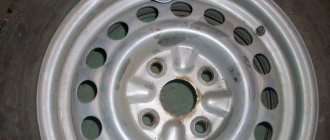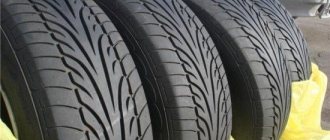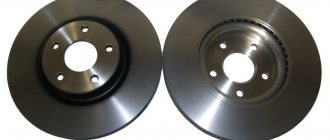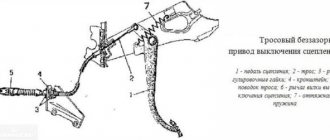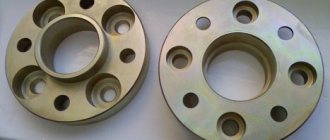Every car enthusiast knows firsthand that when changing tires, the question arises of where to store seasonal tires. Changing tires is necessary in order to drive a car safely and comfortably on the roads.
Some drivers cope with replacing car tires on their own or use the services of tire stations.
And then the question arises - where to store the disks so that they last a long time.
What are the consequences of storing tires incorrectly?
Many of us know that in winter we use winter tires, and in summer we use summer tires. Why is this change necessary? For the production of winter tires, soft and fairly easily bendable rubber is used, which has a deep tread. For the production of summer tires, not so soft rubber with a low tread is used.
Despite the fact that tires are made from different types of materials, they should be stored under the necessary conditions. If these rules are not followed, the rubber will deteriorate.
Unfortunately, the dirt that sticks to the tread pattern will have a beneficial effect on the aging of the rubber. If there are any small or sharp objects, the tire material will crack.
What else affects the damage to tires? How to properly store discs so that they last a long time and without problems?
If the storage location is too low (possible for summer tires) or, conversely, very high (for winter tires), the structure of the material is damaged.
If exposed to direct sunlight, the rubber may dry out, lose elasticity, and cracks may form.
Try to ensure that your tires are stored in an area with moderate humidity. When moisture gets into the structure of the tire material, it begins to lose its elasticity.
How to equip a place to store wheels in the garage
Wheel storage options with and without rims
The storage option for wheels directly depends on their condition. That is, if tires will be stored without disks, then stacking them one on top in the form of a stack is not recommended, since this will affect the shape of the bottom tire.
If the wheels have discs, then the stacking option is allowed, since the main load will be on the discs, not the rubber. At the same time, wheels with rims cannot be placed horizontally in a row, since the weight of the rims will deform the lower part of the tires, while this method is suitable for empty tires. Storage options are clearly demonstrated in the photo above.
Important. In any storage option for empty tires, it is recommended to change their location every 2-3 months in order to change the wheel support point. It is also necessary to remove the covering for ventilation.
You can equip the correct place for storing tires with your own hands:
- Creating a metal rack with a separate shelf for each wheel;
- Construction of suspended shelves under the garage ceiling , which allows you to significantly save space in the room;
- You can use the option of hanging wheels on ropes along the wall , but this is only suitable for wheels with discs.
As alternative options, two more methods can be considered:
- Selling old tires at a reasonable price and purchasing new ones for the next season, if there is such a financial opportunity;
- Temporary storage of wheels in special tire centers, where specialists will maintain the necessary conditions. The price of such a service is relatively inexpensive and allows you to save space in the garage.
When storing wheels with discs, you do not need to inflate them to the required pressure, which is provided for in the instructions for their use on a specific car. It is quite enough to lower the pressure to 0.5 or 0.7 atmospheres.
Important. By keeping winter tires on or without rims, the garage does not have to be particularly prepared in terms of the required temperature or humidity, since they have a different quality of rubber, which is designed for prolonged aggressive exposure to moisture and cold, as well as chemical reagents that are sprinkled on roads to combat snow or ice. However, summer tires are much more capricious.
Preparing tires for proper storage
If you want to store your seasonal tires correctly, listen to the following recommendations and tips on how to best store your rims:
Before storing all car wheels, they must be cleaned of dirt and dust that may be in the tread or pattern. Especially carefully clean the tires from reagents used to clear the road of snow and slush.
It is advisable that the tire shop put marks on the wheels indicating where they were located and on which side. Professional motorists advise swapping wheels - putting the rear wheels on the front and vice versa. This allows the tires to wear evenly.
If possible, preserve tires with silicone. To do this, you need to dilute the silicone (proportion one to one) with boiled water. Use a spray bottle to treat tires.
Immediately before installing the tires, be sure to inspect the tires for damage.
Be sure to take into account the nuance of how long wheels are stored at a tire shop. It is quite possible that unscrupulous technicians will confuse your disks with others.
Basic rules for storing rubber
The reason for these rules is the tendency of the rubber material to deform during long-term storage. The basic rule is that tires must be stored in a vertical position, but they should not be hung.
tires must be stored in a vertical position. Tires can be installed on a plane, but it is better if the surface is concave, semicircular and of a suitable diameter. Such installation of rubber for storage will ensure minimal deformation of the tire.
During long-term storage, tires should be rotated, changing the support area once every month and a half. This avoids changes in the shape of the tread, sidewalls and the appearance of imbalance.
Do not store tires stacked on top of each other. Tires stacked with their weight put pressure on the ones lying below, and their treads gradually deform. Constant long-term pressure causes the carcass and tread profile to round, this is especially important for winter tires. Installing such a tire on a car wheel will lead to a reduction in the contact area of the wheels with the road, a decrease in grip and intense wear in the middle part of the tread.
Choosing storage space
Before considering the rules for storing replacement car tires, you must first figure out where it is best to do this, since any of the listed places in an apartment or house has its own disadvantages and advantages.
Garage
Should you store it in a garage? Although for those owners who have a garage, this place is considered the most optimal. The room must be dry and heated. Heating is needed to store summer tires, as cold air and low temperatures in winter can lead to cracks in tires. In addition, a sharp change in indoor temperature greatly affects the condition of the rubber. But when it comes to storing winter tires, you should give up a metal garage. It overheats greatly in the summer and cools down at night.
Pantry
If you live in an apartment, then the pantry is simply an indispensable place to store a second set of tires without rims. The storage room is located inside the living space, it is free from direct rays, as well as from sudden temperature fluctuations. The pantry is always dry and dark - this is an ideal place to store rubber. The main thing is to avoid contact, or rather not store near aggressive chemicals. The only downside to a storage unit is that in apartment buildings they are usually very small and there is not enough space to store four car tires.
Balcony
For those car owners who live in an apartment and do not have a spacious storage room, the only place left is the balcony. However, storing tires on the balcony has a large number of caveats. Therefore, you need to know how to do this correctly so as not to render the tire unusable by the next season. The best option is a glazed balcony, inside which a certain climate is maintained, which allows you to avoid sudden changes in temperature, but still, it is better to cover the tires with something to protect them from direct exposure to ultraviolet radiation, otherwise they will quickly lose their performance. But with regards to open balconies, it is clear that storage is strictly prohibited. Some car owners pack rubber in plastic bags, thinking that this will protect them from the negative effects of snow, rain, hail, but in fact, this will further lead them to a loss of quality characteristics due to the accumulation of condensation.
If you decide to store car tires on a glassed-in balcony or in a garage, then know that you cannot use them as furniture, for sitting, or pile other heavy objects on them. Moreover, if the rubber was subject to low-temperature storage, then before use it must be brought to the same temperature as outside. And if the tires have previously been used, then before placing them in the garage, on the balcony or in the storage room, they must be thoroughly cleaned and treated. But we will talk about this later.
Washing and processing
It has already been noted that tires must be sent for storage in their pure form. It is worth removing not only dirt, sand and stones from the tread from the surface of the rubber, but also oil stains. Next, it is recommended to apply a special agent with preservative properties to the rubber. You can find such a sprayer on the shelves of any specialized auto store. By the way, if a motorist cannot make a decision on choosing a product on his own, only store consultants will help him in this matter.
It is worth remembering that rubber dye cannot be used to treat tires. In such products, the active component is a solvent, which, with prolonged exposure to rubber, negatively affects it. Before processing, you should carefully study the manufacturer’s instructions for the product and strictly follow them during the application process. Any deviation from the list of actions on the packaging may lead to damage to the tires.
The last step before sending the tires for seasonal storage is packaging the wheels in plastic bags. It is better to use dark-colored bags that will prevent exposure to ultraviolet radiation.
It is important to remember that hermetic closure is not permitted. In the bag where the tires are placed on the rims, condensation will accumulate, which will have a detrimental effect on the metal. In bags where tires are simply stored, it is necessary to ensure good air circulation.
Storage on the balcony
Car owners often store tires on the balcony. If it is glazed, then there is a certain microclimate inside. This circumstance makes it possible to prevent sudden temperature changes and high humidity. But even a glass frame cannot save rubber from the negative effects of sunlight. Therefore, the motorist must independently take care of protecting the tires and pack them in dark plastic bags.
Tires can be stored hanging on the balcony, but only together with rims
Storing wheels on an open balcony becomes almost impossible. This is due to the fact that even packed tires will get rainwater and dirt from the street along with dust. And it is impossible to regulate the temperature by opening or closing the windows on such a balcony.
It is important to remember that at temperatures below +10, the wheels should be immediately removed to a warm room. Therefore, storing wheels on the balcony during the winter season is not recommended.
Storing car tires without rims
In this case, slightly different rules apply. For comparison with the previous method, they are shown in the figure below.
Covers for storing tires can also be used in this case, but plastic bags are better suited here. Their use will prevent debris, dust and dirt from getting inside the tire.
General requirements and rules for storing car tires
Where does seasonal tire storage begin? As in any business, starting with preparatory activities. In this case, seasonal tire storage should begin with washing them. They must be: washed, dried, stones and foreign objects stuck in it must be removed from the tread. In addition, it is advisable to make notes on the wheels which one was used where, for example, right front (RF) or left rear (LR).
This will allow you to navigate when installing wheels next season and carry out rotation, as recommended by the car manufacturer, in order to ensure balanced tire wear.
It will be useful to treat the rubber with a preservative, which will prevent the formation of microcracks in the tires during storage, which contribute to premature wear. Next, you need to decide how seasonal tire storage will be carried out. There are two options here:
- with disks;
- without disks.
The choice of one method or another should be taken very carefully, since the rules for storing tires in each of these cases are different.

